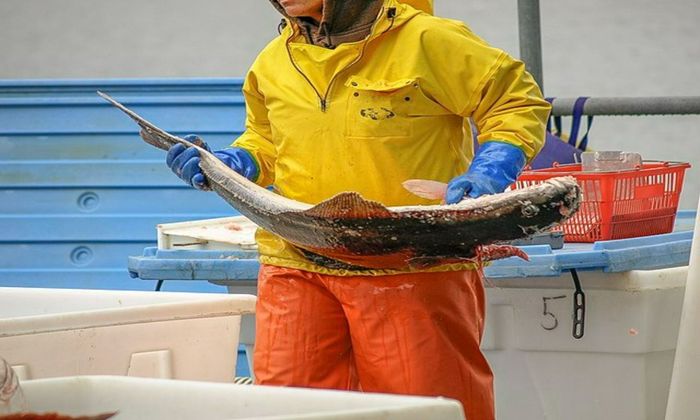10 Endangered Fish Species
Losing just one species would be catastrophic to the whole ecosystem.

Because the effects will be felt across the food chain, losing even one species can have a catastrophic impact on the rest of the wildlife and the ecosystem. The International Union for Conservation of Nature (IUCN) has 1,000 fish species on its list of severely endangered species as of 2017. The list is extensive, but some of the more popular and well-known fish species of particular concern due to their declining population are listed below.
1. Atlantic Halibut

The stock of Atlantic halibut is currently relatively low. Fishing is still permitted, but only in smaller amounts. The Atlantic halibut is overfished but not at risk of overfishing, according to the 2012 stock assessment.
The Atlantic halibut is the largest flatfish, reaching a maximum length of 15 feet. After being caught off the coast of Cape Ann in Massachusetts, the heaviest Atlantic halibut ever caught was eviscerated with the head still attached and weighed 615 pounds. When it was living, it probably weighed 700 pounds. It is a species that takes a very long time to mature and can live for up to 50 years.

2. Beluga Sturgeon
The Caspian Sea's beluga sturgeon, the primary source of wild caviar, is designated as Critically Endangered along with all the other Caspian Sea species that are significant from a commercial standpoint. The relentless pursuit of black caviar, the sturgeon's unfertilized eggs, which are regarded as the greatest in the world, has destroyed beluga sturgeon populations.
Beluga sturgeon caviar can be worth up to US$3500 per pound (US$8000 per kilo), and large people have been known to carry several hundred pounds of the delicacy. The number of eggs a single beluga sturgeon can lay and its extraordinary value make this species the most sought-after fish in the world.
3. Southern Bluefin Tuna
Although southern bluefin tuna are "critically endangered," and their number is only 5 percent of what it was before fishing began, this species is still being overfished. Southern bluefin is the most widely consumed of all listed tuna species sold. Particularly in Japan, it is highly sought after for sashimi. The Australian southern bluefin tuna industry is worth over $100 million a year, and bluefin tuna can fetch prices of up to hundreds of thousands of dollars per fish. With all of this in mind, pressure is mounting to save this species, which is in grave danger.
4. Orange Roughy
The fish species once known as the slimehead by scientists is now recognized by its common name, orange roughy. The predatory orange roughy is found in deep seamounts in most ocean basins worldwide. With individuals surviving for more than 150 years, this species, also known as the Atlantic roughy, is one of the longest-lived marine fish species. Fisheries experts and conservation organizations believe that the orange roughy is overfished throughout much of its range. It may take a population that has been destroyed decades or longer to recover due to the exceptionally long lifespan and the late age at maturity.
5. Nassau Grouper
Due to commercial and recreational fishing, and the loss of reefs, the International Union for Conservation of Nature classified the Nassau grouper as critically endangered. Its thick body and wide mouth can "inhale" prey. Both commercial and recreational fishers pursue the Nassau grouper. Its population has been severely depleted by overfishing in recent years, and it is a slow breeder. Because fishing is so easy to do in its historical spawning grounds, it often eliminates the reproductively active individuals from the population. The IUCN Red List recognizes the species as severely endangered due to its extreme vulnerability to overexploitation.
6. Red Handfish
Handfish are a rare type of anglerfish that use their modified fins, which resemble human hands, to "walk" on the ocean floor instead of swimming. Red handfish were previously only known from a single, 50-meter-long stretch of coral in south-eastern Tasmania. It is estimated that there are only 100 individuals in the entire species. The Red Handfish is protected in Tasmania because it is critically endangered under Australia's Environment Protection and Biodiversity Conservation Act 1999. Red Handfish have now been recognized as Critically Endangered species on the Red List of Threatened Species maintained by the International Union for Conservation of Nature.

7. European Eel
The life cycle of the European Eel is intricate. Adults spawn in the Caribbean's Sargasso Sea, and larvae follow the Gulf Stream current as they move towards European coasts. Before returning to the sea to reproduce once and then perish, eels spend an average of 5 to 20 years living in freshwaters and brackish waterways.
The eel's habitat formerly included all of the EU's waters, including those in the Baltic. Still, today it is primarily restricted to the rivers of the Atlantic EU countries and the Mediterranean. The quantity of eels entering European river systems has dramatically decreased over the past 20 years. According to the IUCN Red List, the European Eel's is "critically endangered."
8. Winter Skate
The cartilaginous fish known as the winter skate has a flat body and pectoral fins that resemble wings. Although skates have thicker tails without any stinging barbs, they compare to stingrays in appearance. There are several different species of skates, including the winter skate.
The IUCN Red List categorizes winter skates as endangered. It takes them between 11 and 12 years to mature enough to procreate and give birth to a few young at once. As a result, they have a moderate population growth rate and are susceptible to abuse. Although they are typically taken when fishers pursue other species, winter skates are harvested for human consumption.
9. Chinese Sturgeon
The Yangtze River, freshwater, and the ocean off China's coast are home to the huge, long-lived native fish called the Chinese sturgeon. The abundance of the wild Chinese sturgeon population has drastically decreased and is still declining. In 2015, the estimated total adult population was 2,569, down from 6,000 in 2010 and 32,260 before 1981. The Yangtze River dam poses a massive threat to the species because it reduces the spawning habitat and modifies water flow and temperature patterns.
10. Atlantic Bluefin Tuna
Bluefin tuna is often highly sought-after in the food sector. The size of the fish and the fact that their flesh is relatively fatty are the causes of this. These animals are specifically caught and used to make sushi or canned tuna. Bluefin tuna are overfished due to the persistent demand for these goods. Their inhabitants have significantly decreased and are now at dangerously low levels. In particular, during the past 40 years, populations of Atlantic bluefin tuna have reduced by 72-82 percent throughout the Atlantic Ocean. Currently, efforts are being made to protect the Atlantic bluefin under the Endangered Species Act.
In North America, part of the effort to save these vulnerable species that may face extinction necessitates anglers obtaining a fishing license and organizations developing a wildlife action plan. Humans are responsible for caring for the environment.




